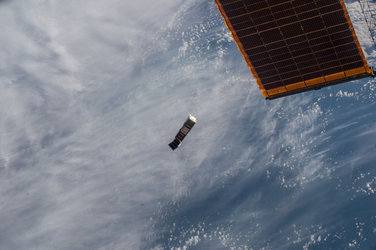Tiny CubeSat tracks worldwide air traffic
Since its launch six months ago, a satellite small enough to fit in an airline passenger’s carry-on bag has been tracking aircraft in flight across the entire globe.
Built for ESA by GomSpace in Denmark, the GomX-3 CubeSat was ejected from the International Space Station on 5 October 2015, along with a Danish student satellite.

“CubeSats are based on standardised 10 cm cubic units,” explains Roger Walker, overseeing ESA’s technology CubeSat effort. “Being small and low-cost, they make ideal platforms for rapidly flight testing experimental technologies.
“This 3-unit GomX-3 is ESA’s very first technology CubeSat to fly. We were able to make it operational within only 96 hours of its release from the Space Station, with a wide variety of tests taking place during the following months.”
GomX-3’s distinctive helical antenna has detected millions of signals from aircraft, building a detailed map of global aviation traffic.
These signals are regularly broadcast from aircraft, giving flight information such as speed, position and altitude. All aircraft entering European airspace are envisaged to provide such automatic surveillance in the coming years.
ESA’s 2013-launched Proba-V first confirmed the feasibility of detection from orbit, opening up the prospect of a global aircraft monitoring system incorporating remote regions not covered by ground-based air traffic control.

GomX-3 also carries a miniaturised X-band transmitter, developed by Syrlinks in France, which has demonstrated the rapid download of data.
In addition, the CubeSat is measuring radio signals emitted by telecom satellites to assess their overall transmission efficiency and how their signal quality changes with respect to distance from their target footprints.
“GomX-3 has in contrast to many other CubeSats demonstrated three-axis control, so it can be pointed as required, whether downwards or upwards, to an accuracy of 3º,” explains Roger.

“A success in terms of planning, speed of development and technical achievements, GomX-3 has now completed its planned six-month technology demonstration mission and continues to operate normally.
“With its orbit naturally decaying from atmospheric drag, the satellite is predicted to reenter and burn up in September of this year.”
GomX-3 was supported by ESA through its General Support Technology Programme, aimed at convert promising engineering concepts into spaceworthy products.
Further ESA technology CubeSats are set for launch later this year. Meanwhile, GomSpace is developing a follow-up 6-unit CubeSat called GomX-4B, also supported by ESA, scheduled for launch in the second half of 2017.















 Germany
Germany
 Austria
Austria
 Belgium
Belgium
 Denmark
Denmark
 Spain
Spain
 Estonia
Estonia
 Finland
Finland
 France
France
 Greece
Greece
 Hungary
Hungary
 Ireland
Ireland
 Italy
Italy
 Luxembourg
Luxembourg
 Norway
Norway
 The Netherlands
The Netherlands
 Poland
Poland
 Portugal
Portugal
 Czechia
Czechia
 Romania
Romania
 United Kingdom
United Kingdom
 Slovenia
Slovenia
 Sweden
Sweden
 Switzerland
Switzerland































